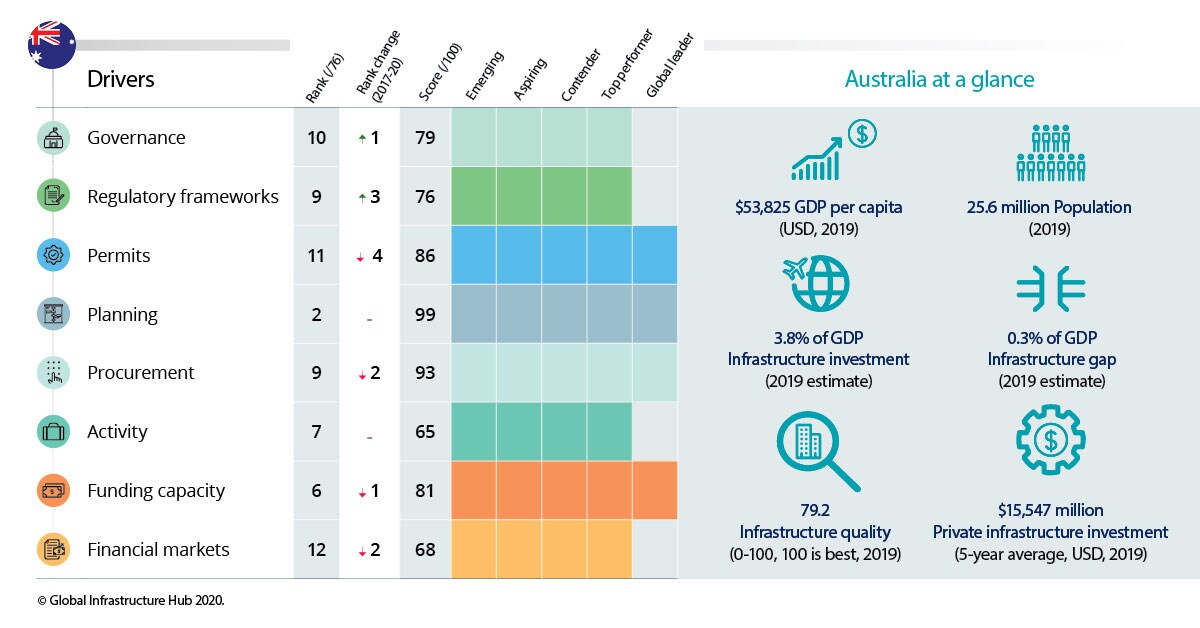This blog was originally published on the Deloitte Australia website.
A common ambition across countries and multinational organisations is to meet the increasing infrastructure need in the face of sustained population growth and urbanisation, changing technologies and service needs, and the social-environmental ambitions of the United Nations Sustainable Development Goals.
Importantly, the recent COVID-19 pandemic could have major impacts on infrastructure investment in ways that are not yet completely understood. However, infrastructure can play a pivotal role in stimulating economies such as Australia’s, that are heading towards a downturn as a result of the pandemic.
Supported by Deloitte, the Global Infrastructure Hub has launched InfraCompass 2020, which provides a comprehensive view of the infrastructure indicators that enable infrastructure investment. The intention is to support governments around the world to identify opportunities to reduce the barriers to investment, improve performance (including through best practice guidance) and encourage greater investment in quality infrastructure. InfraCompass 2020 covers 81 countries, collectively representing 93% of global GDP and 86% of the global population.
InfraCompass 2020 has identified the most important catalysts within each infrastructure driver for unlocking quality infrastructure across 81 countries:
- Funding capacity – credit rating of the government to borrow money for infrastructure spending
- Permits – reliability and transparency of land administration processes
- Procurement – transparency of procurement processes
- Financial markets – the overall depth of the local financial market to sustain relatively large financial transactions
- Governance – protections for creditors to recover their investment if a business or project fails
- Planning – transparent public infrastructure project pipelines to allow the industry to prepare for projects and citizens to have a say
- Regulatory frameworks – the ability of the government to formulate and implement sound regulations to promote infrastructure investment and delivery
- Activity – a strong, recent track record of investment in infrastructure by governments and the private sector.
For Australia, on top of COVID-19, we are also recovering from events such as the recent bushfires and floods, so identifying the catalysts to create resilient infrastructure is important.
InfraCompass 2020 shows that Australia’s strong credit rating and transparent public procurement processes provide favourable conditions for investment in infrastructure projects. Notably, Australia ranks second globally for planning, which encompasses the articulation of the overarching strategic objectives and visions for a country’s infrastructure.

However, Australia has dropped in ranking in a few areas, providing opportunities for progression.
To reduce investment uncertainty, Australia could look to improve procurement processes to shorten the duration and minimise cost and risk.
We need to remove regulation and tax impediments that hold back investment and make the roll-out of projects more difficult. It’s also important to consider market capacity when it comes to using local contractors and services. Competition is a challenge in Australia – it is important we consider our market depth and get the risk allocation right. The long-term impact of the COVID-19 pandemic on Australia’s fiscal position may also impact borrowing costs.
Combined with the leadership and political will to implement reforms, InfraCompass 2020 can help drive greater prosperity by helping to close the infrastructure gap and identify reforms that deliver a greater service outcome for every dollar invested - an important metric for constrained governments and the private sector in a post-COVID-19 world.
To read the full InfraCompass 2020 report, visit the website.
